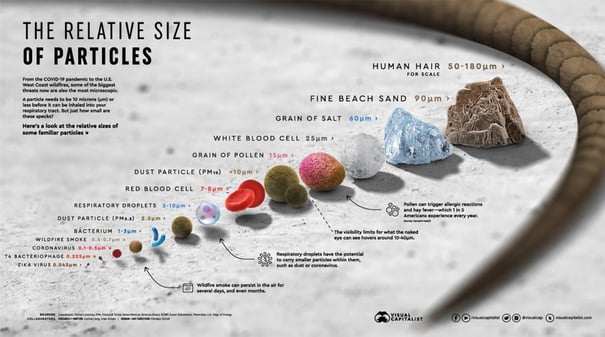The air we breathe is primarily composed of nitrogen and oxygen. What we don't often think about are the other things present in the air we breathe. In fact, air is composed of many other elements and with particles of various sizes. Particulate matter is the sum of all solid particles and liquid droplets in the air. Some particles, such as dust, dirt, soot, or smoke, are large or dark enough to be visible to the naked eye. However, there are also billions of tiny floating particles that we cannot see without special tools. These particles should be monitored because they can harm your physical and mental health.
This infographic from Visual Capitalist shows the relative size of particles around us.

Source: Visual Capitalist
Why should you monitor dust?
Particulate matter can differ in size, with the smallest particles being the most dangerous. PM 10, for instance, refers to particles with an aerodynamic diameter smaller than 10 μm. When the aerodynamic diameter is smaller than 2.5 μm, it is called PM 2.5.
Particulate matter can be divided into three size sorted groups:
- Coarse particles (PM 10) - particles with an aerodynamic diameter of 10 μm or less
- Fine particles (PM 2.5) - aerodynamic diameter is up to 2.5 μm
- Ultrafine particles (PM 0.1) - with an aerodynamic diameter of up to 0.1 μm
The particle sizes differ in origin and health effects. The coarse (bigger) particles (PM 10) can irritate your eyes, nose, and throat. This category includes dust from roads, construction sites, or mines. Combustion of gasoline, oil, and diesel fuel are significant contributors to the PM 2.5 particles found in outdoor air - which can have detrimental effects on our health if breathed in over a prolonged duration. Fine (smaller) particles (PM 2.5) or ultrafine (smallest) particles (PM 0.1) can be more dangerous because they accumulate in the lungs and are not easily coughed out. Subsequently, these particles are able to get deep into our lungs or even diffuse into our blood. As a result, particulate matter can enter the heart, kidneys, and other organs.
Besides these well-established health effects, recent studies also highlight the negative impact of poor air quality on mental health, cancer rates, and decision-making processes. A systematic review from 2022 suggests that air pollution increases the risk of mental health problems such as anxiety and depressive disorders. Other researchers found that reducing air pollution in polluted cities could have a similarly positive effect on cancer rates as eliminating smoking would. Lastly, a 2023 study highlights the impact of poor air quality on strategic decision-making processes based on data from official chess tournaments.
Next to health effects, particulate matter also negatively affects the environment and agriculture. It reduces crop yields by burying seedlings, causing loss of plant tissue, reducing photosynthetic activity, and increasing soil erosion.
We can prevent these health risks and environmental consequences by using a SWARM Air monitor to measure particulate pollution exposure at construction sites, mines, and heavy-traffic areas.

What is Omnidots' SWARM Air monitor?
Omnidots' SWARM Air monitor is one of our newest total solutions for monitoring and reporting dust in the construction and municipal sector. The SWARM Air monitor allows you to measure particulate matter (PM) even in the roughest environments and helps you ensure the health and safety of neighboring residents, visitors, and on-site personnel.
Learn more about SWARM Air